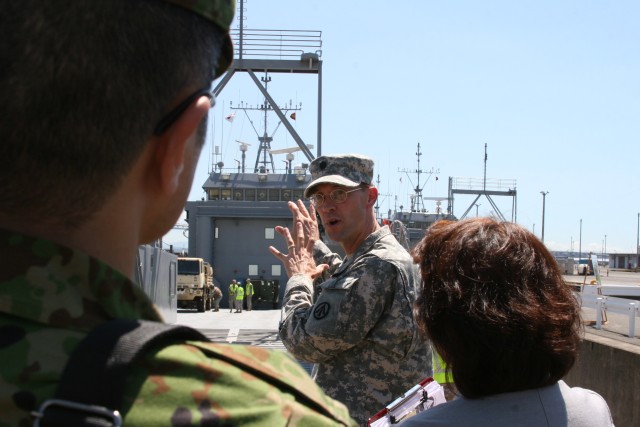A humvee pulled off the U.S. Army Vessel Calaboza onto a boat ramp in Ito City, Japan, Sept. 1, signaling the beginning of American aid to an area devastated by earthquake. All roads in and out of the peninsula had been severed during an 8.7 temblor earlier that day, leaving only passage by helicopter or sea available.
This disaster relief scenario gave SDDC's 836th Transportation Battalion its first opportunity to exercise command and control functions to practice delivering cargo for the Pacific Reach 2010 humanitarian assistance and disaster relief exercise in Japan.
"The 836th's role in Pacific Reach was to provide command and control for the LCUs [landing crafts, utility] here to move equipment to and from Ito City. They supervised the upload and offload safely and tracked the movement and time," said Sgt. Maj. Willie Jacobs, 836th sergeant major.
"This was the first time that U.S. Army Japan has had this big of a stake in the process. The vessels are maintained here, they get exercised maybe twice a year, each particular vessel, apart from maintenance," said Sgt. 1st Class Corey Adams, 836th Transportation Battalion plans and training noncommissioned officer in charge.
SDDC performed reception, staging, onward movement and integration (RSO&I) of cargo, as well as life support functions based on the contingency scenario.
"This all spun off of the Haiti earthquake." Adams said. "Based on an Army unit's strategic location - regardless of our normal function - how can we best employ boots on ground when our friends need help'"
The Army supplied generators, water trailer tanks, and light transportation, as well as personnel to man the generators and drive the trucks. All equipment was shipped by LCUs from the 836th headquarters at Yokohama North Dock to Ito City, about a six-hour cruise.
The 836th stores ten 2000-series LCUs belonging to Army Materiel Command at Yokohama North Dock. The vessels are Army prepositioning stock, so are not manned the rest of the year. Thirty-eight crew members from Fort Eustis went to North Dock to man the vessels in order to participate in the exercise.
While the vessels are a part of Army Prepositioning Stocks-4, from Army Sustainment Command, operational command of the vessels and their crews was the responsibility of the 836th Transportation Battalion during Pacific Reach.
Valerie Van Vleet and Clayton Maciorowski of the 599th Transportation Brigade's information management directorate set up and manned the deployable port operations center during the exercise.
Van Vleet said all aspects of the operations center were fully functional during the exercise, and it proved to be a tremendous command and control asset.
Sept. 1 is Disaster Preparedness Day in Japan. It is the anniversary of the 1923 Great Kanto Earthquake, which killed more than 100,000 people. About 670,000 people participated in disaster preparedness drills around the country this year according to the Yomiuri Shimbun, a Japanese newspaper.
In the lead up to the Sept. 1 landing at Ito City, U.S. Army Japan and the 836th also held a VIP Day at Yokohama North Dock to brief the role Pacific Reach 2010 exercise would play in Disaster Preparedness Day. Gen. Yoshifumi Hibako, chief of staff of the Japanese Ground Self Defense Force, attended.
"It was a great opportunity to work with the Japanese Self Defense Force on a scenario that allows us to help our allies, and we realized our shortfalls in an exercise environment, giving us a chance to correct and perfect our actions," said Jacobs.
In all, two Army LCUs participated in the exercise, USAVs Broad Run, which brought equipment to set up a command and control site in Ito City on Aug. 31, and Calaboza.
Jacobs said the expanded exercise gave the 836th an opportunity to learn some valuable lessons. The exercise gave the vessel crews and the 836th a chance to realize how big a role the tides play in Japan. Because the ramp was very steep, the Caldoza had to back off from the original landing site to drain ballast to lift the bow before it could offload the cargo, according to Jacobs. Trucks onboard the vessel could have cleared the water at the original landing site, but the humvees onboard could not.
Lt. Col. Gregory N. Bunn, commander of the 836th, said the unit plans to expand on the exercise in coming years.
"For next year's exercise we'd like to employ more watercraft and have a bigger scenario, more cargo, which would really stretch the battalion's capability to upload and discharge the vessels. I'd also like to have two or three locations. The bigger scenario would improve our ability to plan and command and control, and to sustain units that task-organized under the battalion."
Pacific Reach 2010 ran from Aug. 27 to Sept. 1, but the soldiers arrived for it Aug 22 and departed Sept. 9.








Social Sharing